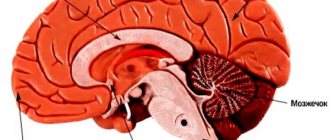Story
The existence of acute short-term psychoses with an extremely severe course and complete remission was recognized and well described by almost all major psychiatrists of the pre-Kraepelin era [1]. After E. Kraepelin identified the group of endogenous psychoses in 1899 and its dichotomy dementia praecox - manic-depressive psychosis, various acute psychoses fell into both of these categories. However, Emil Kraepelin himself argued that there is a “considerable group of disorders” [1] that cannot be classified according to this principle.
With the advent of E. Bleuler’s concept of “schizophrenia” in 1908 and the improvement of Kraepelin’s classification, the problem of acute, short and transient (transient) psychoses with a favorable prognosis was still not resolved [1].
Concepts opposed to Kraepelin and Bleuler led to the identification of a special group of psychoses, different from schizophrenia and bipolar disorder and, in part, schizoaffective disorder, which in the respective countries had the name traditional for the national school of psychiatry [1]:
- Cycloid psychoses
: Germany; - fr. Bouffée délirante
(delusional outbreak): France; - Reactive or psychogenic psychoses
: Scandinavian countries (Denmark, Finland, Iceland, Norway, Sweden); - Atypical psychoses
: Japan; - Certain forms of reactive psychoses (for example, reactive paranoid
,
paranoid reaction
): USSR[2][3].
Other historical names for acute and transient psychotic disorders:
- Acute (undifferentiated) schizophrenia, acute schizophrenic episode;
- Oneirophrenia;
- Psychogenic (paranoid) psychosis;
- Schizophrenic reaction;
- Schizophrenia with a favorable prognosis.
Symptoms of a transient disorder
Signs by which a transient form of personality disorder can be identified:
- delusional states - delusions of persecution, exaggeration of one's own merits, depressive psychosis - rarely;
- hallucinations are short-lived, unlike manifestations of a schizoaffective state;
- disruption of orientation – spatial and temporal;
- reduction of criticism;
- affective state;
- disorders of thinking processes - distortion of judgments, haste in taking important steps, inconsistency in actions and thoughts;
- absent-mindedness.
In most cases, with a transient disorder, not a whole series of symptoms listed are observed, but just one. The manifestation of several signs at the same time may indicate the progression of the disorder and the transition of the pathology to a more complex form, distinguishing a serious mental illness.
Classification
General diagnostic guidelines for acute and transient psychotic disorders in the International Classification of Diseases, 10th Revision (ICD-10)[4]:
- acute onset (up to two weeks), with the development of hallucinations, delusions, incoherent or broken speech, which appear alone or in any combination;
- if confusion, false recognition or disturbances of attention are present, they do not meet the criteria for organically caused clouding of consciousness;
- not consistent with a depressive episode, manic episode, or recurrent depressive disorder;
- psychotic disorder is not associated with substance use;
- Organic brain disease and serious metabolic disorders affecting the central nervous system (except childbirth) are excluded.
The fifth character in the classification indicates the association of the acute onset of a psychotic disorder with acute stress occurring within 2 weeks before the development of acute psychotic symptoms (i.e., F23.x0 - without combination with acute stress, F23.x1 - in combination with acute stress).
The following subcategories are distinguished:
- 23.023.0 Acute polymorphic psychotic disorder without symptoms of schizophrenia.
- 23.123.1 Acute polymorphic psychotic disorder with symptoms of schizophrenia.
- 23.223.2 Acute schizophrenia-like psychotic disorder
- 23.323.3 Other acute predominantly delusional psychotic disorders.
- 23.823.8 Other acute and transient psychotic disorders.
- 23.923.9 Acute and transient psychotic disorder, unspecified.
Causes of transient disorder
In most cases of transient personality disorders, the cause is excessive stress overload and severe nervous shock. What is transient personality disorder is now clear, we need to understand the reasons for this phenomenon:
- daily stressful situations;
- forced long wait for any important decision (for example, judicial);
- divorce and litigation;
- long tiring trips;
- loss of tangible property;
- debts;
- inability to start a family;
- physical and moral violence from relatives.
Some stresses in psychology are usually called “no statute of limitations”, since these traumatic situations can haunt a person throughout his life. Transient disorders are spontaneous in nature, but they recur regularly. It is for this reason that processes of dysfunction not only of the mental sphere, but also of a psychosomatic and autoimmune nature are launched.
Epidemiology
According to the HASBAP study, acute and transient psychotic disorders account for 4% of the total group of non-organic psychoses and affective disorders (in ICD-10 - categories 2. and 3.) [1]. If affective disorders are excluded, their share will be 8.5%[1].
This group of diseases is significantly more often diagnosed in women (female:male ratio = 78.6%:21.4%)[1]. This significantly distinguishes acute and transient psychotic disorders from schizophrenia, for which the risk of development does not differ between men and women[6].
This diagnosis is the most common during the patient’s initial hospitalization in the emergency department[5]:167.
Treatment
Drug therapy for such disorders involves the prescription of drugs that reduce intoxication, as well as antipsychotics. Doses of medications are selected individually; in most cases of the disease, medium and low doses are used, although some situations require the maximum amount of drugs.
Most often, doctors combine Aminazine with Haloperidol, but taking these drugs does not only mean getting rid of an acute condition. In many cases, transient disorders have the ability to relapse, which requires the prescription of these medications for a long course, for several weeks after the end of the main therapy. It is preferable to take medications in the evening.
Psychotherapy is an important point in the treatment of transient disorders. Methods are selected not only those that cope with acute conditions, but also those that identify the causes of the disorders that have arisen - these are psychoanalysis, individual and group cognitive psychotherapy.
After undergoing appropriate treatment, individuals who suffered from a transient disorder can serve in the army; in some cases, such employees are marked “unfit” or “qualified with restrictions” in their personal files. Sometimes, when the condition worsens, such patients are discharged early and treated in an inpatient or outpatient setting. But in most cases, such a pathology does not entail a recall from military service.
It must be remembered that transient disorder is a mild degree of mental disorder, however, one should not treat it irresponsibly. If the diagnosis is made in a timely manner and treatment is started immediately, then the therapy usually quickly produces positive results, and not a trace remains of the pathology. If symptoms are ignored, the disease will progress, developing into more complex forms such as schizophrenia and affective states.
Author of the article: Ermakova Marina Leonidovna, practical psychologist, specialist in developmental psychology
Symptoms and signs
Individuals with an unstable emotional background are prone to transient personality disorders. In this case, a person experiences a violent reaction to a relatively weak external stimulus. The mood changes for any reason, even the most insignificant.
The situation worsens in long-term stressful situations with the constant presence of negative external stimuli or with significant emotional experiences.
A person can flare up for any reason that provokes an outburst of emotions. This usually manifests itself noticeably in intra-family conflicts, when quarrels often escalate into violent acts against family members.
This tendency can manifest itself in behavior even in childhood. A child of an impulsive type, prone to transient disorders, even in preschool age may experience a strong feeling of anger, expressed in an angry cry, an aggressive reaction to all kinds of prohibitions or restrictions.
They often experience increased physical activity, they are capricious, and easily irritated.
They also tend to often experience an angry and gloomy mood , and often conflict with peers.
In adulthood, people of the impulsive type may experience problems in professional teams, which can lead to frequent job changes.
In psychotic disorders, a person of the impulsive type exhibits a sharply negative reaction to any obstacles in achieving goals. In this case, a person is capable of committing illegal actions in an affective state, especially when intoxicated.
A child of the borderline type is characterized by constantly fluctuating self-esteem, changeable impressions of the world around him, fickle aspirations and a low ability to resist the opinions of others.
These people are easily suggestible and quickly come under the influence of the society in which they find themselves, including those with asocial norms.
They are also prone to strong attachment to loved ones , on this basis strong feelings, suffering and conflicts can arise, and suicidal blackmail can be used.
People of the borderline type have highs, during which they feel high spirits, an acute sense of the world around them, and at this time they experience an increase in performance. However, such periods may be replaced by a depressed state.
In general, individuals of this type adapt quite well to a new situation, and are even prone to sudden changes in their personal and professional spheres.
After the changes, they can achieve success professionally and improve their lives.
As a rule, upon reaching 30-40 years of age, emotional lability smoothes out, which reduces the occurrence of transient personality disorders.
Symptoms by which a person can be recognized as having transient personality disorder:
- The presence of delusional ideas of persecution, as well as high or excessively low self-esteem.
- Brief auditory, visual, and taste hallucinations.
- Disorientation in space or time – time can subjectively slow down or speed up, resulting in disorientation in space.
- Attention disorder is the inability to concentrate on the same tasks for a long time, weakening control over the situation.
- Affective states are uncontrollable, antisocial behavior against the background of strong emotional arousal.
- Violation of thought processes - inadequate hasty decisions, illogical conclusions, inconsistent actions and incorrect conclusions in certain situations.
With transient personality disorders, it is not necessary that the entire spectrum of symptoms described will not be observed - only one of them may be manifested .
On the contrary, the simultaneous presence of several of the above signs may indicate more serious mental disorders .











